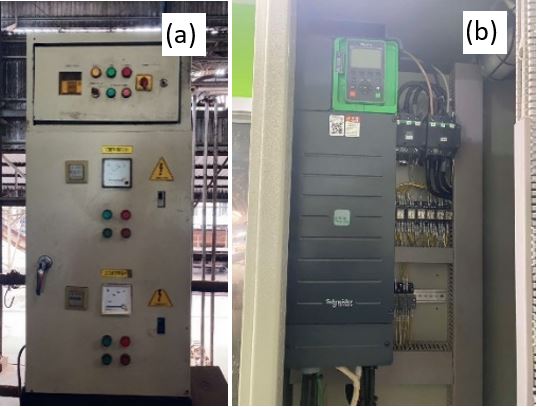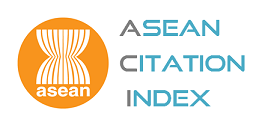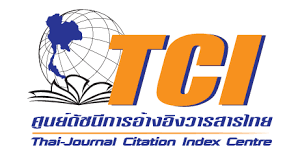Energy Conservation in Palm Oil Mill by Installing Inverters for Motors
DOI:
https://doi.org/10.69650/rast.2025.259834Keywords:
Palm Oil Production, Motor Inverter, Specific Energy Consumption (SEC), Payback Period, Energy EfficiencyAbstract
Thailand is the third largest palm oil producer, accounting for 3.9% of global palm oil production, approximately 84.6%. Energy Efficiency Plan 2018 (EEP2018) aims to reduce energy consumption (Energy intensity) by 30% in 2037. This study investigates the conversational energy of palm oil mills (POM) by installing motor inverters to save energy and reduce the cost of electricity. The experiment was an energy consumption estimate pre- and post-installation of a motor inverter for Thongmongkol Palm Oil Industry Co., Ltd. That analysis used energy consumption and a payback period. The result was that Thongmongkol Palm Oil Industry Co., Ltd. used energy consumption of 4,923.09-6,364.54 MWh. The factory can generate energy for approximately 99% of the factory and purchases from the Electricity Generating Authority of Thailand (EGAT) approximately 1%. These are several motors of 229 units, a Power of 2,785.44 kW, and a horsepower of 3,742.97 HP. Station 4 is the primary process of the oil palm mill. Installing the motor inverter decreases the electricity power consumption by 10.43%. It can save energy costs of 51,091.35 Baht/year. Specific energy consumption (SEC) of 0.013 MWh/ton from 0.015-0.20 MWh/ton. It reduced SEC by 13.33-35.00%. The payback period for installing the motor inverter is 3.16 years.
References
Rielly, K. O. and Jeswiet, J., Strategies to Improve Industrial Energy Efficiency. Procedia CIRP. 15 (2014) 325-330, doi: https://doi.org/10.1016/j.procir.2014.06.074
Owusu, P. and Asumadu–Sarkodie, S., A Review of Renewable Energy Sources, Sustainability Issues and Climate Change Mitigation. Journal Cogent Engineering. 3(1) (2016) 1–14, doi: https://doi.org/10.1080/23311916.2016.1167990.
Onar, O. C. and Khaligh, A., Chapter 2–Energy Sources. Alternative Energy in Power Electronics. (2015) 81–154, doi: https://doi.org/10.1016/B978-0-12-416714-8.00002-0.
Noranai, Z. and MdYusof, M. Z., Economical Analysis of Thermal Energy Storage by Partially Operation. World Academy of Science, Engineering and Technology. 59 (2011) 2567–2571.
Rielly, K. and Jeswiet, J., Strategies to improve industrial energy efficiency. Procedia CIRP. 15 (2014) 325 – 330, doi: https://doi.org/10.1016/j.procir.2014.06.074.
Jun-Jun, M., Takeshi, F., Yiheng, L., Wilailuk, N. and Orathai, C., Greenhouse Gas Emission from Palm Oil Industry in Thailand and its Countermeasures. International Journal of Earth & Environmental Sciences. 6 (2021) 184, doi: https://doi.org/10.15344/2456-351X/2021/184.
Statista. Production volume of palm oil worldwide from 2012/13 to 2023/24, <https://www.statista.com/statistics/613471/palm-oil-production-volume-worldwide/> (2024).
Samart, S., Wathanyu, W., Alongkhon, N., Sirilak, K., Jutturit, T. and Worrajak, M., The Monitoring For Control and Analysis of Electrical Energy Used in Agricultural Production. Case Study of Product Building,Thung Luang Royal Project Foundation. Journal of Innovative Technology Research. 3(1) (2019) 77-90.
Achiraya, C., Pornphimol, W. and Bundit, L., Assessment of renewable energy and energy efficiency plans in Thailand’s industrial sector. Energy Procedia. 138 (2017) 841-846, doi: https://doi.org/10.1016/j.egypro.2017.10.105.
International Energy Agency (IEA). Where does Thailand get its electricity?, <https://www.iea.org/countries/thailand/electricity> (2024).
Department of Alternative Energy Development and Efficiency (DEDE), Ministry of Energy, Thailand, Energy Efficiency Plan 2018-2037 (EEP2018), http://berc.dede.go.th/wp-content/uploads/2023 /03/20201021_EEP_2018_Final-1.pdf> (2018).
Wongkot, W., Analysis of energy reporting and verification system under Thailand energy management system. Energy Procedia. 110 (2017) 38-44, doi: https://doi.org/10.1016/j.egypro.2017.03.103.
Phiromporn, T., Wongkot, W., Det, D., Gengwit, W. and Napaphat, L., Policy investigation and evaluation of electricity utilization comparison between public and private office buildings in Thailand. Energy Report. 8 (2022) 827-833, doi: https://doi.org/10.1016/j.egyr.2022.07.100.
Staudacher, M., Josef, K. and Caroline, W., Optimizing the control strategy of redundant motor-inverter systems for aircraft propulsion application. Journal of Physics Conference Series. 2772 (2014) 012009, doi: https://doi.org/10.1088/1742-6596/2772/1/012009
Sopit, D., Wongkot, W., Tassawan, J., Waranya, T., Varoon, R., Phitsinee, M. and Chaichan, R., Tracking the Real-World Energy Efficiency Measures: Does Past Industrial Sector Performance Can Accelerate Thailand’s NDC Target Achievement?. Chemical Engineering Transactions. 106 (2023) 19-24, doi: https://doi.org/10.3303/CET23106004.
Tripathi, L., Mishra, A., Dubey, A., Tripathi, C. and Baredar, P., Renewable Energy: An Overview on its Contribution in Current Energy Scenario of India. Renewable and Sustainable Energy Reviews. 60 (2016) 226–233, doi: https://doi.org/10.1016/j.rser.2016.01.047.
Akvile, L., Patrik, T., Mariana, A. and Magnus, K., Specific Energy Consumption/Use (SEC) in Energy Management for Improving Energy Efficiency in Industry: Meaning, Usage and Differences. Energies. 12(2) (2019) 247, doi: https://doi.org/10.3390/en12020247.
Ediwan, E., Arnawan, H., Abu, B., Muhammad, D., Adi, S. and Nelly, S. Analysis of the Use of Electric Energy in a Single Phase Induction Motor to Drive a Bio-Pellet Machine from Empty Palm Bunch. in International Conferences on Applied Engineering, Science, Technology and Innovation. (2024), 87-96, doi: https://doi.org/10.4028/p-ld4inN.
U.S. Department of Energy. In Improving motor and drive system performance: A sourcebook for industry, Colorado: National Renewable Energy Laboratory, (2008) 1-60.
Zamri, N., Nurul, F., Muhammad, A., Noradila, A. and Nur, Z., Improving Energy Efficiency at Palm Oil Mill Industries, Journal of Physics: Conference Series. 1874 (2021) 012013, doi: https://doi.org/10.1088/1742-6596/1874/1/012013.
Kushairi, A., Singh, R. and Ong-Abdullah, M. The Oil Palm Industry in Malaysia: Thriving with Transformative Technologies. Journal of Oil Palm Research. 29(4) (2017) 431–439, doi: https://doi.org/10.21894/jopr.2017.00017.
Muda, K. and Ezechi, E. H., Overview of Trends in Crude Palm Oil Production and Economic Impact in Malaysia. Sriwijaya Journal of Environment. 4(1) (2019) 19–26, doi: http://dx.doi.org/10.22135/sje.2019.4.1.19.
Madli, F., Noranai, Z., Jaat, N. M., Salleh, H. and Yusof, M. Z. Md., Development of Split Air Conditioning System using Chill Water as the Cooling Medium. International Journal of Mechanical and Mechatronics Engineering. 6(8) (2012) 1676–1679.
Ani, F. N. and Nor, N. M., Energy index for palm oil processing in oil palm mills. 1(2) (2010) 112–123.
Energy Efficiency Council. Calculate energy savings 101, https://www.energybriefing.org.au/calculating-energy-savings (2024).
Muhammad, A. N., Tjahjono, H. and Meta, R., Analysis of Palm Biomass as Electricity from Palm Oil Mills in North Sumatera. Energy Procedia. 47 (2014) 166-172, doi: https://doi.org/10.1016/j.egypro.2014.01.210.
Nasrin, A., Stacy, S. R., Ahmad, S., Ali, A. Z., Li, P. W. and Nik, M. B. N. S., An Investigation of Sustainable Power Generation from Oil Palm Biomass: A Case Study in Sarawak. Sustainability. 8(5) (2016) 416, doi: https://doi.org/10.3390/su8050416.
Warman, E., Iqbal, M. N. and Fahmi, F., Efficiency analysis of electric energy use in palm oil processing (case study Bandar Pulau). in the 1st International Conferences on Industrial and Manufacturing Engineering. (2018), 012048, doi: https://doi.org/10.1088/1757-899X/505/1/012048.
Rupani, P. F., Singh, R. P., Ibrahim, M. H. and Esa., N., Review of current palm oil mill effluent (POME) treatment methods: Vermicomposting as a sustainable practice. World Applied Sciences Journal. 10(1) (2010) 1190-1202.
Dalimin, M. N., Renewable energy update: Malaysia. Renewable Energy. 6(4) (1995) 435-439, doi: https://doi.org/10.1016/0960-1481(94)00070-M.
Awalludin, M. F., Sulaiman, O., Hashim, R. and Nadhari, W. N. A. W., An overview of the oil palm industry in Malaysia and its waste utilization through thermochemical conversion, specifically via liquefaction. Renewable and Sustainable Energy Reviews. 50 (2015) 1469-1484, doi: https://doi.org/10.1016/j.rser.2015.05.085.
Wu, T. Y., Mohammad, A. W., Jahim, J. M. and Anuar, N., A holistic approach to managing palm oil mill effluent (POME): Biotechnological advances in the sustainable reuse of POME. Biotechnology Advances. 27(1) (2009) 40-52, doi: https://doi.org/10.1016/j.biotechadv.2008.08.005.
Akhbari, A., Zinatizadeh, A. A., Vafaeifard, M., Mohammadi, P., Zainal, B. S., and Ibrahim, S., Effect of operational variables on biological hydrogen production from palm oil mill effluent by dark fermentation using response surface methodology. Desalination and Water Treatment. 137 (2019) 101-113, doi: https://doi.org/10.5004/dwt.2019.23169.
Okotie, L. E. and Collins, O., Evaluation of the kilowatts (kw) energy consumption for a mini palm oil factory operation. International Journal of Engineering Processing & Safety Research. 28(5) (2023) 227-230.
Omokhafe, T., Eli, T., Babatunde, A., Yahaya, E. and Ovis, I., Investigation of Electrical Energy Efficiency and Current Harmonic Mitigation of Electrical Drive: A Case Study of Sunti Golden Sugar Company Nigeria. FUOYE Journal of Engineering and Technology. 9(2) (2024) 181-188, doi: https://doi.org/10.4314/fuoyejet.v9i2.5.
Mohamed, S., Rehab, M. E. M. and Mohamed, F., Valuation of Variable Speed Drives to Improve Energy Efficiency and Reduce Gas Emissions: Case Study. Chemical Industry and Chemical Engineering Quarterly. 29(2) (2023) 111-118, doi: https://doi.org/10.2298/CICEQ220318018S.
Alfa, F. and Syamsul, M. Creating the standard for specific energy consumption at palm oil industry. Sinergi. 20(1) (2016) 9-13, doi: https://dx.doi.org/10.22441/sinergi.2016.1.002.

Downloads
Published
How to Cite
Issue
Section
License
Copyright (c) 2025 School of Renewable Energy and Smart Grid Technology (SGtech)

This work is licensed under a Creative Commons Attribution-NonCommercial-NoDerivatives 4.0 International License.
All copyrights of the above manuscript, including rights to publish in any media, are transferred to the SGtech.
The authors retain the following rights;
1. All proprietary rights other than copyright.
2. Re-use of all or part of the above manuscript in their work.
3. Reproduction of the above manuscript for author’s personal use or for company/institution use provided that
(a) prior permission of SGtech is obtained,
(b) the source and SGtech copyright notice are indicated, and
(c) the copies are not offered for sale.







